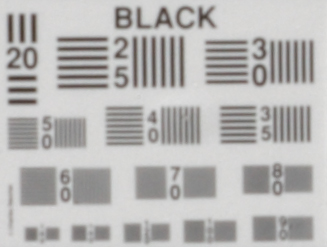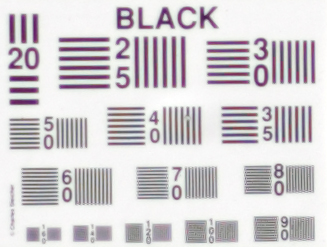IN STOCK!
For Sony mirrorless or Leica L.


|


|

$200 Leica BP-SCL6 Lithium-Ion Battery (8.4V, 2200mAh) BACK IN STOCK in Accessories: Batteries and Power
|

|

|

|
Diffraction: A Technical Challenge
Related: depth of field, diffraction, digital sensor, Nikon 85mm
Today’s high-resolution digital sensors cannot be fully exploited unless a fine line is rowed between the Scylla and Charybdis of optical aberrations and diffraction. Stop down too little and optical aberrations limit image quality and depth of field. Stopping down too far to increase depth of field results in diffraction-killing image contrast and resolution. (The foregoing ignores artistic considerations).
Mouse over the f/45 image below to see f/5.6 and note the huge contrast and sharpness difference.

There exist exceptional lenses that broaden the working aperture range straddling the Two Perils, but with today’s digital SLRs the only truly optimal aperture with many lenses is f/8 (f/5.6 with smaller photosite cameras). The foregoing is true with nearly all lenses, even though the differences might be subtle and undetected by most users. Outstanding lenses might broaden that range to f/4 - f/8. Consumer-grade lenses might always disappoint, and indeed might require f/11 to overcome optical shortcomings (especially in the corners), leaving no flexibility for artistic considerations in the choice of aperture, should optimal quality be desired.
The following rule of thumb is nearly invariant, depending on your threshold for “critical” image quality:
The foregoing has few exceptions if one is willing to examine image quality critically. The rule can be skewed appropriately depending on photosite size; really small photosites as found on cameras like the EOS 40D and Nikon D2x show diminished contrast even before f/8. Large photosites as found on cameras like the Canon EOS 5D and Nikon D3 will tolerate f/11.
Also, there exist some outstanding lenses that are optimal or near optimal just one stop down from maximum aperture, though it is the rare lens that can perform optimally across an entire 36mm X 24mm frame. Most lenses require 3 stops to reach optimal performance: f/4 for an f/1.4 lens, f/5.6 for an f/2 lens and f/8 for an f/2.8 lens.
Example—Nikon 85mm f/2.8D PC-Micro-Nikkor
The center-of-frame crops shown below were taken using the 10.1-megapixel Canon EOS 1D Mark III with the Nikon 85mm f/2.8D PC-Micro-Nikkor using a Nikon-to-EOS adapter. The 85mm PC-Micro-Nikkor is a top-performing optic and so it can be expected to achieve top imaging quality 1-2 stops down from maximum aperture, and to show the effects of diffraction no later than f/11. Also, the EOS 1D Mark III has relatively large photosites, and so is moderately “forgiving”. Cameras with smaller photosites like the EOS 40D and Nikon D2x and EOS 1Ds Mark III will show a less forgiving range of optimal apertures.
The 85mm PC-Micro-Nikkor also stops down to f/45, allowing a very clear demonstration of the quality-destroying effects of diffraction.
Resolution vs contrast
Resolution is only a rough concept without also considering contrast. In considering the actual-pixels crops below, take note of not just the resolved line pairs, but also the contrast—the degree to which black remains black and white remains white (both considered together to accommodate minor exposure variation). Note also:
- acutance—the crispness of the edges.
- the “160”, “140”, “120” text clarity.
- spurious resolution (colored speckles) seen in the 90/100/120 bars (goes away as diffraction blurs the resolved detail).
There appears to be a small exposure variation between frames (physical aperture settings are not 100% accurate after all). The important thing is to observe the trend. Optimal aperture for this camera/lens combination appears to be f/4, though f/5.6 and f/8 are as good (and corner performance might improve at f/5.6 and f/8—not shown/tested for in this example).
By f/11 there is a subtle but noticeable decline in contrast which can be tolerated for real-world images. But f/16 is going gray and soft in the fine detail, something which will reduce the “sparkle” of an image along with both real and perceived resolution, especially in low contrast areas of real images. This test chart is very high contrast; images that start with low contrast are going to lose resolution as gray undifferentiated detail even more quickly.
Aperture f/22 is unacceptable for most usage, and f/32 and f/45 are simply awful—now you know why most lenses don’t offer any aperture smaller than f/16 or f/22.

Photosite size
The table below lists the approximate photosite sizes for various Nikon and Canon camera bodies. The photosite size is calculated from sensor size and resolution; actual “fill factor” and other sensor characteristics can affect the effective photosite size slightly.
Using the Canon EOS 1D Mark III as a reference (see Example on this page) we can draw certain conclusions about the smallest (size) aperture to be used for optimal quality (assuming a top-quality lens). Stop down no more than one stop beyond that figure when depth of field is a high priority. These figures are also based on vast field experience with a variety of Canon and Nikon DSLRs over the years (and see also D2x vs EOS and D200 vs D2x and The Sharpest Image).
| Camera | Approximate Photosite Size (microns) | Smallest Optimal f/ |
|---|---|---|
Canon EOS 5D (12.7MP)
|
8.2 | f/13 |
Canon EOS 1D Mark III (10.1MP)
|
7.4 | f/9 |
Canon EOS 1Ds Mark III (21.1MP)
|
6.4 | f/8 |
Canon EOS 40D (10.1MP)
|
5.7 | f/6.3 |
Nikon D3 (12.1MP)
|
8.4 | f/14 |
| Nikon D3x (24MP) | 5.95 | f/7 |
Nikon D300 (12.3MP)
|
5.5 | f/6.3 |
Note that although the theoretical diffraction limit for the Canon EOS 1D Mark III is about f/22, image degradation in terms of contrast loss is already seen two stops prior at f/11.
8-bay Thunderbolt 3
2.5 or 3.5 inch hard drives, NVMe SSD, USB-C, USB-A, DisplayPort 1.4, SD slot, PCIe slot, 500W power supply.
Non-RAID or RAID-0/1/4/5/10.
Capacities up to 128 Terabytes!
A technical challenge
It is technically challenging to fully exploit the sensor of cameras like the 21.1-megapixel Canon EOS 1Ds Mark III; a full-frame sensor and small photosites will disappoint (on a per-pixel basis) with anything but the very best lenses in perfect optical alignment shot at the optimal aperture and focused perfectly.
The author’s extensive personal experience with the 5.5-micron-photosite Nikon D2x taught him that the 5.x-micron range is a difficult area for lenses, even with a “sweet spot” 2/3-frame sensor. New and improved optical designs do mitigate the issue somewhat, but cannot overcome the inherent resolution/contrast constraint exerted by the laws of physics.
With pixels that are 1.3X larger (linearly) and 72% larger in area, the Nikon D3s will be a more forgiving camera to shoot than the 21.1-megapixel EOS 1Ds Mark III. The 9 megapixel resolution difference will sometimes be of little consequence when optical limitations, focus accuracy and human perception are considered. The “smart money” might wisely consider high ISO performance and other image quality factors when choosing between such cameras.
Conclusions
Ignoring artistic considerations, there is a very narrow band of optimal apertures at which to shoot with today’s digital cameras. Understand the issue and make your choices with specific subject matter accordingly.
The future
As DSLRs move towards 30 megapixels and beyond, diffraction will become the dominant factor in limiting resolution. In late 2009, the 24 megapixel Nikon D3x shows that f/5.6 is the best aperture with a top-grade lens; beyond that contrast at first subtly drops at f/8, with a rapid falloff at f/11 and beyond. With a 40 megapixel camera, the limiting aperture will become f/4!




















